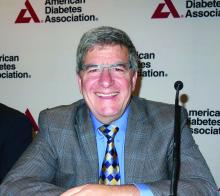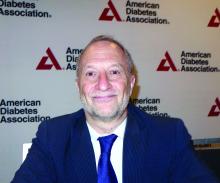BARCELONA – Further differences in how adults and adolescents with type 2 diabetes respond to glucose and glucagon have been demonstrated by new data from the Restoring Insulin SEcretion (RISE) studies presented at the annual meeting of the European Association for the Study of Diabetes.
In a comparison of responses to an oral glucose tolerance test (OGTT), youth (n = 85) were more likely than were adults (n = 353) to have a biphasic type of glucose response curve (18.8% vs. 8.2%, respectively), which is considered a more normal response curve. However, that “did not foretell an advantageous outcome to the RISE interventions in the younger age group,” said study investigator Silva Arslanian, MD, of UPMC Children’s Hospital of Pittsburgh.
Fewer youth than adults had an incessant response (10.6% vs. 14.5%, respectively) or monophasic response to an OGTT (70.6% vs. 77.3%), and that was associated with lower beta-cell responses, compared with individuals with monophasic or biphasic glucose curves.
“Irrespective of curve type, insulin sensitivity was lower in youth than in adults,” Dr. Arslanian said. She added that beta-cell responses were greater in youth than in adults, except in youth with the worst incessant-increase curve type. In youth with the incessant-increase glucose curve, there was no evidence of beta-cell hypersecretion, which suggested youth “have more severe beta-cell dysfunction,” compared with adults.
There were also data presented on whether differences in alpha-cell function between youth and adults might be important. Those data showed that although fasting glucagon concentrations did not increase with fasting glucose in youth, they did in adults. It was found that fasting and stimulated glucagon concentrations were lower in youth than in adults, meaning that “alpha-cell function does not explain the beta-cell hyperresponsiveness seen in youth with impaired glucose tolerance or recently diagnosed type 2 diabetes,” reported study investigator Steven Kahn, MD, ChB, of VA Puget Sound Health Care System, University of Washington, Seattle.
“This is a batch of secondary analyses,” Philip Zeitler, MD, PhD, of Children’s Hospital Colorado, Aurora, said in an interview. Dr. Zeitler, who chaired the session at which the new findings were unveiled, noted that the main data from the RISE Pediatric Medication Study (RISE Peds) were published last year (Diabetes Care. 2018;41[8]:1717-25) and results from the RISE Adult Medication Study (RISE Adult) were just presented this year, and explained that the timing difference was because the adult study took longer to complete its target accrual.
Results of these studies showed that, compared with adults, youth were substantially more insulin resistant and had hyperresponsive beta cells. Furthermore, their beta-cell function deteriorated during and after treatment for type 2 diabetes, whereas it improved during treatment and remained stable after stopping treatment in adults (Diabetes. 2019;68:1670-80).
The idea for the RISE trials came about around 6 years ago, with the overall aim of trying to identify approaches that could preserve or improve beta-cell function in younger patients and adults with dysglycemia, Dr. Zeitler explained. When the trials were being planned it was known that young patients with type 2 diabetes often needed much higher doses of insulin, compared with their adult counterparts. So, it “wasn’t entirely unexpected” that they were found to be insulin resistant, particularly, as puberty is an insulin-resistant state, Dr. Zeitler observed.
“What was new, however, was that [the beta-cells of] youth were hyperresponsive and were really making large amounts of insulin.” Increased insulin production might be expected when there is insulin resistance, he added, but the level seen was “more than you would expect.” Over time, that might be toxic to the beta cells, and evidence from the earlier TODAY (Treatment Options for Type 2 Diabetes in Adolescents and Youth) studies suggested that the rate of beta-cell dysfunction was more rapid in youth than in adults.
Giving his perspective, as a pediatrician, on the new OGTT analyses from the RISE studies, Dr. Zeitler said that these data showed that the characteristic beta-cell hyperresponsiveness seen in youth “actually disappears as glycemia worsens.” In youth with the incessant glucose response pattern, “it shows that they cannot tolerate glucose, and their glucose levels just go up and up and up” until the beta cells fail.
This is a critical observation, Dr. Zeitler said, noting that it “sort of had to be the case, because sooner or later you had to lose beta cells ... this is probably the point where aggressive therapy is needed ... it was always a bit of a paradox, if these kids have such an aggressive course, how come they were starting out being so hyperresponsive?”
With regard to alpha-cell function, “these are really fresh data. We haven’t really had a long time to think about it,” said Dr. Zeitler. “What I find interesting is that there isn’t alpha-cell glucagon hypersecretion in youth like there is in adults.” That may be because youth are making so much insulin that they are suppressing glucagon production, but that’s not an entirely satisfying answer,” he said.
“The TODAY study demonstrated that diabetes in kids is aggressive; these RISE data now start to put some physiology around that, why is it more aggressive? Hyperresponsiveness, loss of beta-cell function over time, lack of response to intervention, compared with the adults.”
As for the clinical implications, Dr. Zeitler said that this is further evidence that the default approach to treating younger patients with greater caution than adults is perhaps not the best way to treat type 2 diabetes.
“These data are really showing that there is a very important toxic period that is occurring in these kids early on [and] that probably argues for more, not less, aggressive therapy,” than with adults. “Clearly, something is happening that is putting them at really big risk for rapid progression, and that’s your chance to treat much more aggressively, much earlier.”
The RISE studies are sponsored by the RISE Study Group in collaboration with the National Institute of Diabetes and Digestive and Kidney Diseases. Dr. Zeitler disclosed that he had acted as a consultant to Boehringer-Ingelheim, Eli Lilly, Daiichi-Sankyo and Merck, Sharp & Dohme, and had received research support from Janssen. Dr. Arslanian stated that she has nothing to disclose. Dr. Khan did not provide any disclosure information.
SOURCES: Arslanian S. EASD 2019, Oral presentation S34.1; Kahn S. EASD 2019, Oral presentation S34.3



